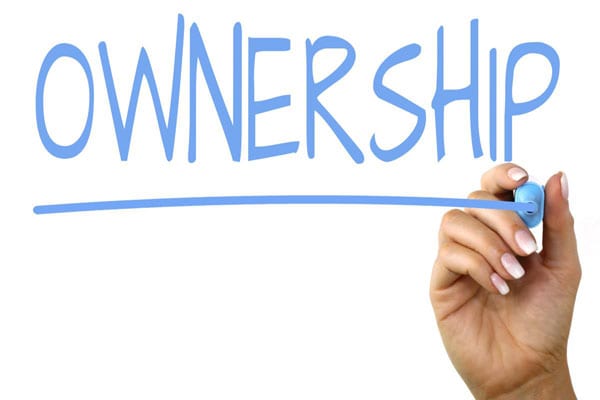
NPQ will be exploring these issues in more detail on a special webinar we’ll be hosting on Thursday, December 13th, at 2 pm Eastern Time. Don’t miss this opportunity to bring the promise of this set of tools to your community-strengthening practices.
Ownership is often seen as a very simple concept. “Mine, not yours,” a two-year-old might tell us. The reality, however, is far more complex, as the rights of owners are far from fixed. Indeed, the concept of what ownership means is itself subject to change. For this reason, achieving greater social and economic justice is not just about changing who owns economic assets, but also changing what rights are associated with owning assets. This is because ownership is not simply about who is the legal owner, but also forces us to consider what ownership is and what we mean by the term “ownership.” Fundamentally, ownership is not about possession in isolation; rather, it involves a social relationship of legal rights among people.
The reality that ownership is not absolute is particularly obvious if we reflect upon the question of ownership of land. Rhetoric aside, a US homeowner is hardly the king or queen of his or her “castle.” You want to tear down a family home and build a mid-rise apartment building on your pied-à-terre? How about converting your private kitchen into a commercially operating restaurant? If you try to do these things in a typical US residential neighborhood, you’ll quickly learn that your right to “private property” is not as extensive as you thought. Not to mention: you’ll surely end up with many angry neighbors!
If your home is in a neighborhood governed by a housing association, you might even find limits on what color you can paint your house or how you take care of your front lawn. We often speak about property ownership as an absolute right, but, again, property is a social relation—your use of “private” property is limited by both law and custom.
Indeed, reflecting this insight, real estate law courses typically describe ownership as a “bundle of rights,” rather than a thing.1 And such an ownership “bundle of rights” is not fixed, but varies according to what you and your neighbors agree constitute “private rights” as opposed to other rights that may be assigned to local government or your friendly homeowners’ association.
Typically, the bundle of rights is altered to fit specific zoning or neighborhood guidelines. But the bundle of rights can also be altered in other ways too—for example, a community can choose to alter homeownership rights with the goal of promoting broad-based housing affordability.
A community land trust (CLT) is one such strategy for changing the bundle of rights for this purpose. With a CLT, the homeowner owns the home, but the trust owns the land underneath the home; a deed or contract sets forth the rights of each party. As with a fee-simple house, the homeowner retains the rights to privacy, to exclusive use of the home, and to bequeath the property to heirs. But the trust has rights, too. Most notably, it can set a resale formula to preserve affordability, set limits on capital improvements (again, to preserve affordability—hard to do that if you allow teardowns and the replacement of modest homes with McMansions), insist on repairs (to preserve the long-term value of the housing for future owners), and set limits on refinance. This last nonprofit trust right ended up being crucial in our nation’s last major economic downturn, protecting thousands of CLT homeowners from taking on predatory loans and is one reason why CLT homeowners had dramatically lower foreclosure rates than fee-simple homeowners during the Great Recession.
Land banks change the distribution of rights in a different way, by giving the local government the right to acquire vacated land without offering the land up for auction on the market when an owner fails to pay taxes. Land banks’ purpose is less about housing and more about control of vacant units. A land bank is typically publicly owned—most often, at the county level. The land bank acquires vacant property, engages in public planning, invests in improvements that meet community needs, and then re-sells the land to private owners.
Yet another approach to community ownership of housing is the housing cooperative. A housing cooperative is, as its name would suggest, a business in which residents collectively own housing. housing cooperative is, as its name would suggest, a business in which residents collectively own housing through a housing corporation governed by the cooperative principle of “one member, one share, one vote.” Housing cooperatives are a very established form of housing —New York City is known as a hub for housing cooperatives in part because it was the easiest way to allow residents to collectively own housing back in the days when the legal concept of a condominium (where each family owns its own apartment or townhome unit separately) had yet to be developed. Some New York City housing co-ops can be very exclusive; in 2016, one 20-room co-op “apartment” on Fifth Avenue listed for a cool $120 million.2 But while celebrity-owned co-ops get the press, co-op housing typically is a tool for people with limited means to collectively own property. The National Association of Housing Cooperatives reports that roughly one percent of all housing units in the US—about 1.2 million—are housing cooperatives.3
In recent years, additional forms of community control of land have been developed. One of these is the resident-owned community (ROC) cooperative model. Of course, technically, all housing cooperatives are resident-owned. But the term has been deployed to refer to co-op housing that involves establishing community land ownership in manufacturing housing communities (also known as “mobile home parks” or, even less positively, trailer parks). Community land ownership of these communities is important because manufactured housing is the leading source of affordable market-rate housing in the United States.
Sign up for our free newsletters
Subscribe to NPQ's newsletters to have our top stories delivered directly to your inbox.
By signing up, you agree to our privacy policy and terms of use, and to receive messages from NPQ and our partners.
More than 17 million Americans live in manufactured housing.4 Residents are disproportionately low-income—with median household income about half of the national average.5 Cooperative land ownership allows these residents to stabilize land tenancy rather than being at constant risk of literally having the land sold out from under them. Community ownership helps build resident wealth because secure land tenancy enables residents to access better financing (i.e., pay less interest on their loans) and enjoy higher resale values. Residents get better financing, of course, because community land ownership means the buyer will become a co-op member and therefore will also enjoy secure land tenancy; this makes the property more valuable and makes bank loans to residents less risky, enabling residents to obtain lower interest rate loans.
The largest organization supporting the development of these resident owned communities is ROC USA, which has assisted 227 parks to become resident-owned properties.6 ROC USA began as a program of the New Hampshire Community Loan Fund. By the mid-2000s, the New Hampshire Community Loan Fund’s success attracted national attention. With the support of the Ford Foundation, Prosperity Now (formerly the Corporation for Enterprise Development, or CFED) and others, ROC USA was created and the effort to create manufacturing home communities gained a national push. As of 2018, 14,500 manufactured homes in 15 states are part of ROC USA (more than double the amount since 2008).7
Last, but not least, the community land trust (CLT), as mentioned above, achieves permanently affordable housing by changing that “bundle of rights” that we like to call ownership. CLTs enable non-profit community-based organizations to take land off the market and place it in a trust, thereby preserving housing affordability. Typically, most of the equity gain accrues to the trust and only a minority accrues to the resident, allowing the trust to offer housing to a subsequent low-moderate-income owner at an affordable price.
More than 15,000 families own homes on CLT property. These homeowners have most of the rights that we associate with homeownership, but not all. For example, in exchange for buying their house at a below-market rate, the buyer agrees to restrictions on refinancing and on the price for which they can sell the home. The mechanisms might be recorded in the deed of sale or be incorporated in a ground lease. In either case, these restrictions help preserve affordability for future homebuyers (and have the not-insignificant side benefit of keeping home buyers from overleveraging their homes. For example, during the Great Recession, while serious delinquencies for the population at large ranged from 6.3 percent in 2008 to 9.67 percent in 2009, CLT borrowers’ delinquency rates ranged from 1.98 percent in 2008 to 1.3 percent in 2010.8
It is hard to overstate the significance of those low community land trust delinquency numbers. Given that a loss of wealth in communities of color exceeding one trillion dollars occurred during the Great Recession, the bottom line is that if community land trusts had been widespread at that time, tens, if not hundreds, of billions of dollars of wealth that was lost in the Great Recession might have been preserved. Yet the growth of community land trusts remains slower than the dramatic positive impacts of community land ownership would justify.
Fortunately, successful cases of community land trust development are beginning to proliferate. A potentially game-changing victory for CLT advocates took place in 2017 in Baltimore, Maryland, where the community-based 2020 campaign has advocated for investment in community land trusts. The 20/20 Campaign has sought $20 million in funding for affordable housing, with community land trusts a central element, and $20 million to deconstruct blighted properties. In May 2017, Baltimore Mayor Catherine Pugh publicly declared her support of the group’s proposal, which is expected to support the building of 400 affordable homes and employ 550 residents.9 At NPQ, in the past year, we have also highlighted the growth of community land trusts in many other communities—including the San Francisco Bay Area, New York City, Washington DC, Philadelphia, and Florida—to name a few prominent examples.
Community land trusts, as noted above, typically serve as a strategy for developing affordable housing, but the purpose of community ownership of land can be conceived of more broadly to include community ownership of commercial land, green space, and community facilities. A couple of years ago, I interviewed Susan Witt, who worked for years with land trust pioneer Bob Swann and who directs the Massachusetts-based Schumacher Center for New Economics. Witt notes that Swann helped develop the community land trust model to avoid commodifying land, since land “is not earned but is nature given.” Swann, Witt says, “saw the community land trust movement as a land reform movement.” Witt adds that Swann envisioned the community land trust might hold about a tenth of a community’s land to ensure that development occurred in accord with community values. “We developed a two-tiered system,” Witt says, “not only land for housing, but land for working farms, land for manufacturing sites, and land for our main streets to make sure retail sites are affordable for locally owned businesses … In the end, the result would be a diversified and distributed wealth.”10
Updated figures were provided from ROC-USA on December 13, 2018.
Notes
- See for instance, this article by former Vermont Supreme Court Justice Denise Johnson: Denise R. Johnson, “Reflections on the Bundle of Rights,” Vermont Law Review, volume 32 (2014), pp. 247-272, accessed March 15, 2017.
- Amy Plitt, “$120M Co-op at 834 Fifth Avenue Is Now NYC’s Most Expensive Listing: Say hello to the new most expensive home for sale in New York City,” @CurbedNY, April 26, 2016, accessed March 15, 2017.
- National Association of Housing Cooperatives, Housing Cooperatives in the USA, Washington, DC: NAHC, March 2012, accessed November 30, 2018.
- United States Census Bureau, “Total Population in Occupied Housing Units by Tenure by Units in Structure,” Washington, DC: US Dept. of Commerce, based on 2012-2016 American Community Survey data, 2018, accessed November 30, 2018.
- Corporation for Enterprise Development, “Facts about Manufactured Housing,” About Manufactured Housing,” Washington DC, 2017, accessed March 27, 2017.
- ROC USA, “Strategic Plan 2015–2018” ROC USA: Concord, NH, 2015: 4, accessed Jan. 7, 2016. Updated December 2018 data provided by ROC-USA.
- ROC USA, “10,000 Strong and Growing,” 10,000 Strong and Growing, Concord, NH: ROC USA, 2016, accessed on Jan. 7, 2016. Updated December 2018 data provided by ROC-USA.
- Jeff Bounds, “Community Land Trust Lending Update, Part 2,” Fannie Mae Business News, January 28, 2016, accessed March 15, 2017.
- Luke Broadwater, “Pugh backs calls for multimillion investment in affordable housing in Baltimore,” Baltimore Sun, May 13, 2017, accessed May 15, 2017.
- Susan Witt, telephone interview by Steve Dubb and Emily Sladek, November 3, 2016.











